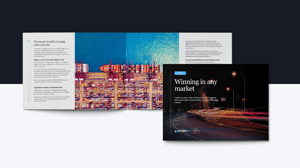Have you heard the Yogi Berra quote that "It's tough to make predictions, especially about the future"?
This is the unfortunate reality of New Product Introductions (NPI). Far too often NPI result in a costly gap between what you thought was going to happen and what actually does.
When it comes to new product launches, you can’t just hope for the best. A successful NPI forecast is both realistic and risk-aware. It's built more on consensus and less on guesswork. More anticipation. Less fire-fighting.
In this post, let's start by digging into "why" and then we'll take a closer look at "how."
Forecasting NPI: A tug-of-war between optimism and realism
You’ve probably heard the phrase “forecasting is both an art and a science.” Let’s unpack that.
On the one hand, you’ve got the “art”—subjective insights based on years of industry experience and gut instinct. The problem? Gut instinct is full of biases. As humans, we tend to remember (and inflate) the successes and conveniently forget the failures.
Then, there’s the “science” of forecasting which involves using data, algorithms, and historical trends to predict future demand. Sounds great, right? But for NPIs, that’s like trying to predict tomorrow's weather based on what happened yesterday in a completely different city. It might be obvious, but the biggest challenge of forecasting new product launches is the lack of historical sales data.
So what do you do? You've got to thoughtfully blend art and science. And use what you do have—which may be more than you think.
Using "science" to overcome the challenges of new product forecasting
Many companies are quick to lean on their collective experience in the absence of historical sales data (i.e., "art"). But don't forget, this is where overconfidence, optimism, and groupthink can creep in, biasing the initial forecast.
Luckily, there are some objective forecasting alternatives that can be used for NPI:
- Like-Item Forecasting: Look at historical data from similar product launches to predict your new product’s potential.
- Conjoint Analysis: Understand what your customers value and how much they’ll pay for it.
- Probabilistic Modeling: Map out various outcomes, assigning probabilities to each scenario.
But it doesn't stop there. Good demand forecasting involves multiple dimensions of input.
Multi-dimensional approach to demand forecasting
Whether it's for new products or existing SKUs at other product lifecycle stages, best-in-class demand forecasting has multiple dimensions:
- Statistical Forecasting: Use historical data, seasonality, and other statistical methods to build a baseline forecast.
- Demand Sensing: Add in economic signals, consumer sentiment, social media trends, point-of-sale data, and other real-time insights that explain buying behaviors and fine-tune the baseline forecast.
- Consensus: Aligning stakeholders to a unified forecast that can be actioned.
- Demand Shaping: Proactively influence demand through targeted promotions, personalized pricing, and other agile adjustments to close the gap between the most likely forecast and aligned NPI goal.
NPI forecasting & supply chain agility
We know that risk is a part of every product launch. So why not factor it into your forecasting process? Here’s how we typically help product leaders create more resilient NPI forecasts:
- Scenario-based planning: Create multiple forecasts based on different market conditions, competition, and customer behaviors to aid decision makers in aligning the NPI sales forecast with the risk tolerance of the business. Don't just look at the upside scenarios.
- Sensitivity analysis: Understand how changes in key factors like pricing or marketing spend could impact demand. What happens if these variables shift?
- Dynamic performance monitoring: NPI isn’t static. Your forecasts shouldn’t be either. Constantly fine-tune the plan as real-time data and market conditions change.
- Cross-functional collaboration: NPI forecast shouldn’t be created in a vacuum. Sales, marketing, operations, and finance all need to contribute their insights. The more perspectives, the more accurate the forecast.
Leveraging AI for NPI forecasting—what to consider
As we sit at the midpoint of 2025, it is clear that AI is no longer a buzzword. When used properly, AI-enabled forecasting can take new product launches to the next level.
Identifying how historical demand predicts the future is a key challenge for NPI forecasting because "like products" are difficult to identify and traditionally left to demand planners to figure out. But today's machine learning and AI models are incredibly good at recognizing patterns using product attribute data, sales patterns, and even image and color clustering to pull trend information from historical demand in a much more sophisticated way.
Here’s the main benefits of using AI for NPI forecasting:
- More accurate predictions: AI can process huge amounts of data, identify hidden patterns, and provide insights that traditional forecasting methods might miss.
- Faster decisions: AI can automate the heavy lifting of data analysis, helping you make decisions faster and more accurately.
- Continuous learning: AI-based forecasts don't just sit there. These data models learn and improve over time. With feedback loops and machine learning, your forecasting models get better every time.
But don’t make the mistake of thinking AI is a magic fix. It’s only as good as the data and systems you put behind it. To maximize the power of AI in demand forecasting, you need:
- Solid data governance: Clean, accessible data is essential.
- User training and adoption: Your team needs to know how to use and interpret AI-generated insights.
- AI governance framework: The ethical deployment of AI is crucial.
Forecast new products with confidence
Forecasting new product launches doesn’t have to be a shot in the dark. It’s time to leave blind optimism behind and adopt a more structured, risk-aware approach. Using the right approaches and processes—along with AI—will enable your organization make smarter, data-driven decisions.
We at Spinnaker SCA get it. NPI is tough, but not impossible. We’ve helped companies optimize their NPI forecasting using a blend of proven methodologies and cutting-edge technology. Are you ready to stop guessing and start planning smarter? Let's talk.




.png?width=300&name=NPI%20Blog%20(1).png)